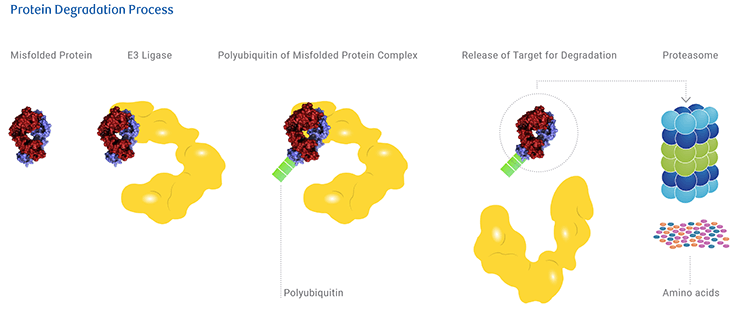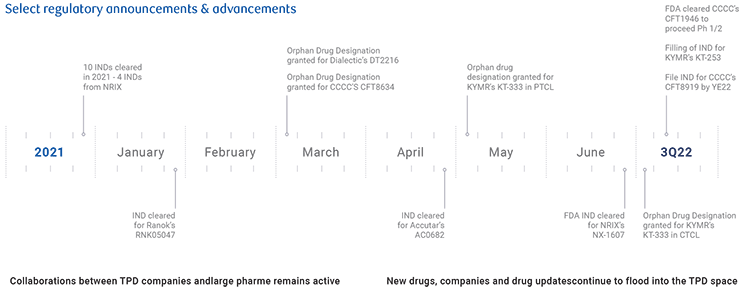Published February 8, 2023 | 3 min read
Key Points
- PROTACs offer a new way to target malfunctioning proteins in the cells that cause diseases from cancer to autoimmune disorders.
- 2023 will be a pivotable year for the technology, with a number of Phase I/II trial data and the potential for regulatory filings strategies to be released.
- While the full story on safety, efficacy and tolerability is still to be told, the promise of this exciting new technology is prompting significant investment.
It sometimes seems like as we discover more and more about how the human body works, we get as many new problems as we do potential solutions. By mapping the human genome, medical researchers have opened up a world of possibilities in identifying and treating diseases, but they’ve also uncovered just how massive that world is.
Proteins, for example, are large, complex biomolecules produced through a series of processes based on instructions from DNA and are fundamental in daily normal processes of equilibrating the human physiology. When there is a malfunction they become a prime driver of diseases, misfolding or mutating, causing overproduction and aberrant/uncontrolled activation, leading to cancers, inflammation and neurodegenerative diseases. Identifying this fact is a huge step forward, but the trouble is that proteins number in the tens of thousands and conventional small-molecule and antibody drugs can only access about 20% of the proteins we produce.
The arrival of PROTACs
In 2001, an entirely new mechanism was proposed, protein-targeting chimeric molecules or PROTACs. These use the body’s own natural cell-cleaning process to help get rid of proteins that are behaving badly. The body already has a process to rid itself of proteins that are old, mutated, misfolded, or have otherwise completed their functions, using the ubiquitin proteasome system. It’s basically a version of taking out the trash.

The unwanted protein is tagged with multiple small regulatory proteins called ubiquitin, which are recognisable to a highly sophisticated protease complex called the proteasome. The proteasome degrades the tagged proteins by proteolysis, a chemical reaction that breaks their peptide bonds. You can think of it as something like a recycling center, since what comes out at the end are short amino acid sequences that can be used to synthesize new proteins.
Our cells are constantly at work making and disposing of proteins to try to make sure we have the right ones in the right amounts. But disease-causing proteins often escape that process. What the PROTACs do is tag the disease-causing protein and then let the proteasome take care of it. The PROTAC is a small molecule with two active ends, one that binds to the ‘bad’ protein and the other to a protein called E3 ubiquitin ligase – the tag. That marks the protein for the proteasome, cleaning up house.
The next stage in the evolution
The initial publication in 2001 showed that PROTACs were worth investigating. In the intervening decades, researchers have been doing just that, and 22/23 has the potential to be a pivotal year for the technology’s viability in clinical use. Promising preclinical agents have now advanced to first-in-human ph.I trials in indications such as oncology and inflammation/immunology, with strong interest in the use case for neurodegenerative diseases as well. Among the leaders in the space, we can now expect a cadence of frequent and abundant clinical data readouts for their degraders in development.
The investments made in the past five to ten years towards pushing degraders to the clinic could yield multiple approved drugs in the future that will have a lasting positive outlook for patients of unmet medical need. The idea is also expanding to molecular glue and RNA degraders, which are vying to piggyback off of the success of the targeted protein degraders with similar mechanisms to gain relevance. Drugs in these classes will progress to clinical trials, although protein degraders have a higher chance of yielding positive patient outcomes with a proven mechanism of action in the near future.

Already by the first half of 2022, there are 14 new companies and 88 newly disclosed targeted protein degradation (TPD) drugs. This sets the stage for a steady stream of clinical program updates for years to come.
Breast cancer is currently the leading disease indication among TPD drugs in development, with the expectation of targeted degradation providing an effective means to hone in on disease pathways to produce sustained therapeutic effects. The utility of TPD technology in neurological disorders has also been of high interest. Protein depositions in the brain continue to be targeted as a pathophysiology of neurological disorders, lending speculation towards TPD technologies as a viable means to a breakthrough therapeutic technology in neurological disorder treatment.
What lies ahead
While positive clinical readouts in the landscape have kept expectations high, the biggest hurdles may lie ahead. There have been two decades of progress since the first 2001 article on PROTACs, but most trials are still early in ph.I, so long-term safety, tolerability and preliminary efficacy readouts remain to be seen.
As companies in the space begin their later-stage trials and programs, more differentiation between competitors in the same industry should become evident. Progress will also include new avenues of research, including hematology and inflammatory diseases.
How robust this technology is will help contribute to its ability to gain regulatory approval and broad adoption. And while there are outstanding questions about the exact mechanisms for TPD, the clinical data so far shows a strong place for the technology in modern medicine.
Gregory Renza and Yinglu Zhang authored “Targeted Protein Degradation - An Emerging Frontier of Therapeutics Disruption,” published on October 26, 2022. For more information about the full report, please contact your RBC representative.


